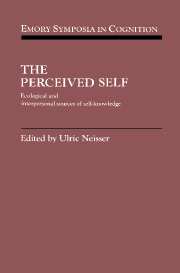Book contents
- Frontmatter
- Contents
- Preface
- List of contributors
- Part I Introduction
- Part II The concept of an ecological self
- Part III The interpersonal self and its implications
- 8 The self born in intersubjectivity: The psychology of an infant communicating
- 9 On the interpersonal origins of self-concept
- 10 Infants' knowledge of self, other, and relationship
- 11 The role of feelings for an interpersonal self
- 12 Spontaneous communication and the foundation of the interpersonal self
- 13 Autism, affordances, and the self
- 14 Through feeling and sight to self and symbol
- 15 G. H. Mead and Martin Buber on the interpersonal self
- 16 Cognitive science, other minds, and the philosophy of dialogue
- Author index
- Subject index
12 - Spontaneous communication and the foundation of the interpersonal self
Published online by Cambridge University Press: 29 March 2010
- Frontmatter
- Contents
- Preface
- List of contributors
- Part I Introduction
- Part II The concept of an ecological self
- Part III The interpersonal self and its implications
- 8 The self born in intersubjectivity: The psychology of an infant communicating
- 9 On the interpersonal origins of self-concept
- 10 Infants' knowledge of self, other, and relationship
- 11 The role of feelings for an interpersonal self
- 12 Spontaneous communication and the foundation of the interpersonal self
- 13 Autism, affordances, and the self
- 14 Through feeling and sight to self and symbol
- 15 G. H. Mead and Martin Buber on the interpersonal self
- 16 Cognitive science, other minds, and the philosophy of dialogue
- Author index
- Subject index
Summary
Western philosophers often see something puzzling about knowing another person's “inner” meanings when one has access only to behavior: This is the “other minds” problem (Austin, 1959). William James noted: “Our senses only give us acquaintance with facts of the body, and … of the mental states of other persons we have only conceptual knowledge” (1890, pp. 222-223); Ludwig Wittgenstein argued: “When we communicate a feeling to someone, something which we can never know happens at the other end. All that we can receive from him is an expression” (1965, p. 185).
This chapter describes a spontaneous communication process in which expressive behaviors constitute “facts of the body” that are veridical signs of motivational-emotional states. Given attention, these expressive behaviors provide all we need to know about what has happened at “the other end.” It is argued that communication proceeds in two simultaneous streams: a symbolic stream, which is learned, intentional, and prepositional; and a spontaneous stream which is biologically based, direct, nonpropositional, and based on subcortical and paleocortical brain systems. The chapter presents spontaneous communication as the basis of the interpersonal self, and summarizes relevant research in a variety of subject groups.
- Type
- Chapter
- Information
- The Perceived SelfEcological and Interpersonal Sources of Self Knowledge, pp. 216 - 236Publisher: Cambridge University PressPrint publication year: 1994



